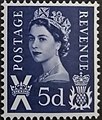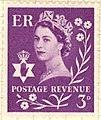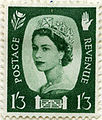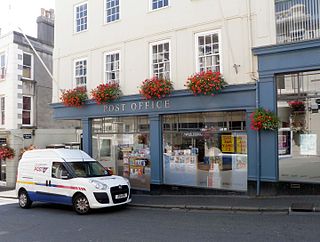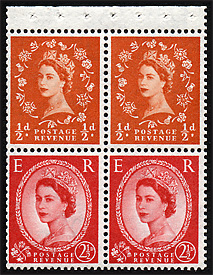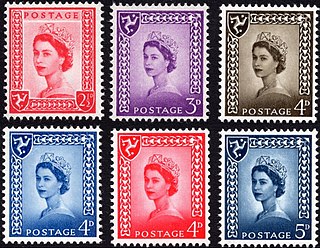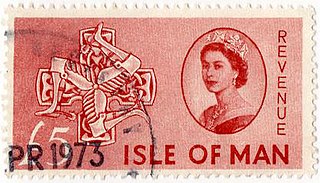1958 issues
Special committees were established to choose the heraldic emblems or symbols for the each country or island. These are discussed in the sections below. The first value (3d deep lilac) of the regional issues were introduced on 18 August 1958 [5] in the Channel Islands, the Isle of Man, Scotland, Wales and Northern Ireland. The design consisted of the Dorothy Wilding's portrait of the Queen surrounded by appropriate regional symbols. Other values were introduced at later dates. Some of the issue dates are unclear, as the stamps were first issued at the Philatelic Bureau in Edinburgh, others first at the Philatelic Counter in London, yet others first in the region.
The colours used were consistent across the various regions, and stayed constant with the exception of the 4d value, which was issued in three different colours – initially ultramarine, then olive-sepia and finally vermilion. The 4d's initial colour change was made to bring it into line with that used by the newly issued pre-decimal Machin series (from 5 June 1967 onwards). The Machin 4d's colour was then changed because of complaints that the date of postmarks (critical for football pool entries) could not be read on so dark a colour. All the regional 4d's were then changed again to the new Machin colour of vermilion.
Scotland
The Scottish Committee chose designs by John B. Fleming, Gordon F. Huntly and Archie B. Imrie. [6]
- 5d denomination (design also used for 3d and 4d)
Wales
The symbols selected by the Welsh committee were the Welsh Dragon (passant) and the leek. Three designs by Reynolds Stone were chosen. [7]
Northern Ireland
There were perceived to be some particular problems creating the Northern Ireland definitives because of a lack of symbols that might be used to represent Northern Ireland while avoiding contentious political symbolism. The committee charged with organising the choice of design decided on Dorothy Wilding's portrait of the Queen augmented with symbols: the Red Hand of Ulster (the emblem of the O’Neills – the royal house of Ulster); the Arms of Northern Ireland (without supporters); the six-pointed Crowned Star with the Red Hand; the Flax Plant (with or without leaves); and a Field Gate with Ulster pillars. Several local artists were chosen to present designs and one from each was chosen by the Queen. The artists were: Thomas Collins; Leonard Pilton; William Hollywood; Colin Middleton; Miss T. Robinson. Three, Collins; Pilton and Hollywood were chosen to be issued. [8] [9] [10]
- 3d denomination (design also used for 4d and 5d issued later)
- 6d denomination (design also used for 9d issued later)
- 1/3d denomination (design also used for 1/6 issued later)
Channel Islands
Eric Piprell designed the Guernsey stamps. These show the Crown of William the Conqueror and the Guernsey lily as described in the book The Lilium Sarniense by James Douglas published in 1975. He also designed the 2+1⁄2d, which showed a variation of the Lily and Crown theme. The Jersey stamps were designed by William Gardner, with the exception of the 2+1⁄2d issue which was designed by Edmund Blampied. The Gardner design showed the Mace presented to the island by Charles II in 1663 and the Arms of Jersey as the main subjects with a potato and tomato plant in the borders to emphasise the importance of agriculture. The Blampied design also used the Mace and Arms, but in different positions and omitted the plants. Source: Channel Islands Stamps and Postal History, published by Stanley Gibbons in 1979.
Jersey and Guernsey became postally independent on 1 October 1969 when they each issued their own inaugural series.
- Guernsey 2+1⁄2d regional issue of 1964; design by Eric Piprel
- Jersey 2+1⁄2d regional issue of 1964; design by Edmund Blampied
Isle of Man
The Isle of Man stamps, designed by John Nicholson, included the tre cassyn (Three Legs) escutcheoned (on a shield), the three spurs looking rather like stars, and had a bordering ring-chain pattern based on designs on ancient Manx stone crosses. [11]
